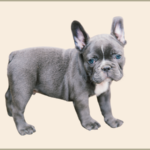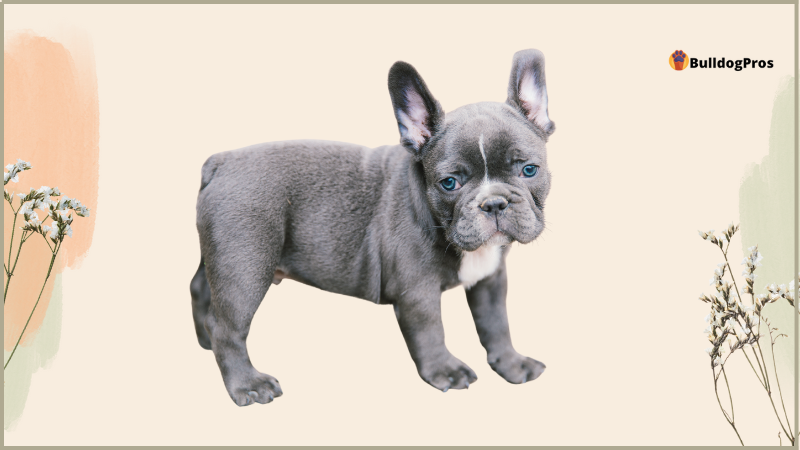Have you ever wondered what a blue French Bulldog is all about? Are you interested in learning more about this unique dog breed? In this blog, Blue French Bulldog: Facts, Breed Information & Health Issues, we’ll discuss all things blue French bulldogs, from their history to breed standards and health concerns.
So whether you’re looking to buy a puppy or are just curious, we hope you find everything you need here!
Blue French Bulldog: Quick Guide
- Breed Name: Blue French Bulldog
- Origin: France
- Size: Small, typically 11-12 inches tall at the shoulder
- Weight: 16-28 pounds
- Coat Color: Predominantly blue, often with white markings
- Temperament: Affectionate, playful, and loyal
- Lifespan: 10-12 years
- Exercise Needs: Low to moderate
- Grooming: Low maintenance, regular brushing
- Health Issues:
- Brachycephalic syndrome
- Hip dysplasia
- Allergies
- Patellar luxation
- Obesity
- Special Care:
- Avoid overheating due to their flat faces
- Regular dental care
- Watch for signs of allergies and skin issues
- Training: Can be stubborn, but positive reinforcement works
- Price Range: $3,500 – $6,000 or more, depending on pedigree
- Popularity: One of the most popular small dog breeds
What is a Blue French Bulldog?
A blue French Bulldog is one of the color variations found in the Frenchie.
French Bulldogs come in various colors and coat types, but blue is undoubtedly one of the more eye-catching varieties.
These dogs have a loving demeanor and are among the most popular French bulldog breeds.
Like all French Bulldogs, blue French Bulldogs are vulnerable to health problems. Breathing difficulties, hip dysplasia, and seizures are just a few.
Video: Blue French Bulldog: Facts, Breed Information & Health Issues
The History of the Blue French Bulldog
Like other colored Frenchies, the French bulldog breed originated in England as a toy-sized bulldog. With the Industrial Revolution came a migration from England to Northern France, and the Frenchie was brought to France with their owners.
Over the years, the toy Bulldogs were crossed with what is thought to be terriers and pugs, and their now-famous bat ears were developed.
Frenchies became popular all over Europe and America by the end of the nineteenth century.
Coloring
The blue color in Blue French Bulldogs is a result of a dilution of the standard black coat color gene. It’s important to note that “blue” in the context of French Bulldogs doesn’t refer to a pure blue color like the sky or ocean; instead, it represents shades of gray, ranging from dark gray to a lighter slate gray.
Here’s how the blue coloration in French Bulldogs comes about:
Genetic Dilution:
The coat color in dogs is determined by various genes. The blue color in French Bulldogs is caused by a dilution gene known as the “D” allele. This gene dilutes the standard black color to various shades of gray. When a dog inherits two copies of the “D” allele (one from each parent), it will display the blue coat color.
Breeding:
Breeders who want to produce Blue French Bulldogs specifically pair dogs that carry the “D” allele. When two carriers are bred together, there’s a chance that some of their offspring will inherit two copies of the “D” allele and thus have blue coats.
Variability:
The blue color can vary from one dog to another. Some Blue French Bulldogs may have a darker gray or almost black appearance, while others may be a lighter silver-gray. The nose and eye color of Blue French Bulldogs can also vary, with blue or light blue eyes and a blue nose.
It’s important to note that while Blue French Bulldogs are visually distinct due to their coat color, the genes responsible for the blue coloration do not impact their temperament, health, or behavior. However, breeders should be cautious when breeding for coat color to ensure they prioritize the overall health and well-being
The eyes of blue French Bulldogs are usually blue or light blue though as a puppy grows, the blue eyes may become brown.
You Might Also Be Interested In Reading: The White French Bulldog
Blue French Bulldog Colors
There are a few color variations found in the blue Frenchie
- Blue Brindle
- Blue coat with brindle streaks.
- Blue Fawn
- As the name suggests, these Frenchies are blue and fawn in color.
- Blue Merle
- An irregular and unusual combination of patches and streaks.
- Blue Pied
- Blue coat with patches of white or cream.
The Temperament of the Blue French Bulldog
French Bulldogs’ gentle and loving nature is well-known, making them wonderful family dogs. They also enjoy being around other animals.
With the high-energy this dog breed exhibits, it’s important to give these pups both physical and mental stimulation to help curtail boredom and destructive behavior. By socializing and providing plenty of playtime they will eventually calm down.
To Read More About The Temperament of Frenchies, See: The French Bulldog and Behavior
Blue French Bulldog Health Issues
If you’re thinking about adding a Frenchie to your family, it’s essential to know what kind of health risks they may face so that you can take appropriate precautions.
Some health problems are common in all French Bulldogs. Epilepsy, hip dysplasia, and respiratory difficulties are the most common issues.
It’s important to know that the French Bulldog being a flat-face breed, is at risk for Brachycephalic Syndrome. Frenchies can become overheated quickly and are at risk of heatstroke.
According to, veterinarian Dr. Roy Kraemer who specializes in treating French and English bulldogs, a dog with Brachycephalic syndrome at times may require surgery. However, not all French bulldogs will require surgery, but their flat faces can lead to other conditions that involve consistent maintenance, including skinfold, eye and eyelid, dental, and ear diseases.
Blue Frenchies are prone to an inherited condition called Color Dilution Alopecia (CDA). CDA causes areas of hair loss or thinning. This will usually start anytime after six months.
It’s important to note that not all blue Frenchies will develop CDA, but if they do, It is relatively easy to manage with the help of a vet.
If you observe any concerning signs in your Frenchie, consult with a veterinarian. In the meantime, to avoid health concerns in the future, be proactive about your dog’s well-being and exercise them regularly.
Frenchie Male vs. Female
It’s important to note that these differences are general tendencies, and individual variations can be significant. The personality and behavior of a Blue French Bulldog are influenced by factors such as genetics, upbringing, socialization, and training.
| Male | Female | |
| Size | Males tend to be slightly larger than females, both in height and weight. They might have a more robust build. | Females are generally a bit smaller and lighter than males. They may have a more petite and delicate appearance. |
| Behavior | Male French Bulldogs can be a bit more energetic and playful, especially when they are young. They may exhibit more “puppy-like” behavior throughout their lives. | Female French Bulldogs tend to be calmer and more reserved, especially as they mature. They might exhibit less boisterous behavior. |
| Territorial | Some male French Bulldogs may display territorial tendencies and mark their territory more often, making house training and marking behavior a potential concern. | While females can still be territorial, they may be less likely to engage in marking behavior compared to males. |
| Social Interaction | Males are often more social and may be more outgoing with strangers. They might seek attention and playtime with people and other dogs. | Females can be more selective in their social interactions and may take longer to warm up to new people or dogs. They might be more independent. |
| Dominance | In some cases, males can be more dominant, which may require consistent training and socialization to ensure they are well-behaved and obedient. | In general, females may be less dominant and more cooperative. They might be easier to train in some cases. |
FAQs
Is the blue Frenchie recognized by the AKC?

The American Kennel Club (AKC) does not recognize the blue Frenchie when it comes to breeding standards, despite its beauty.
That doesn’t indicate the dog isn’t lovely or has a wonderful personality; it simply means that the color isn’t recognized.
Are blue French Bulldogs rare?
Yes, the blue Frenchie is one of the rarest colors available in the French bulldog breed. Because of this, they can also be quite pricey.
Are blue French Bulldogs good with other pets?
Blue French Bulldogs can get along well with other pets in the household, including cats and other dogs. Proper introductions and gradual acclimation are important when bringing a new Blue French Bulldog into a home with existing pets.
Some Blue French Bulldogs can display a territorial or dominant attitude, so it’s essential to monitor their interactions and address any potential issues.
Additional Reading

Bulldog Breeds – The Ultimate Guide

Best DNA Test Kits For Dogs – Buying Guide
Conclusion
Well, there you have it. The blue French bulldogs are just as adorable and energetic as their other French Bulldog relatives.
They do come with some potential health issues, so it’s essential to have regular vet visits and know of the possible added expenses.
With a friendly, loving, and playful personality, they have become one of the most desired breeds to own.
If you are considering purchasing a blue French Bulldog, be sure to contact a reputable breeder.
Thank you for reading Blue French Bulldog: Facts, Breed Information & Health Issues, and I hope you found it helpful.
What are your thoughts about the blue French Bulldog? Please comment below.

